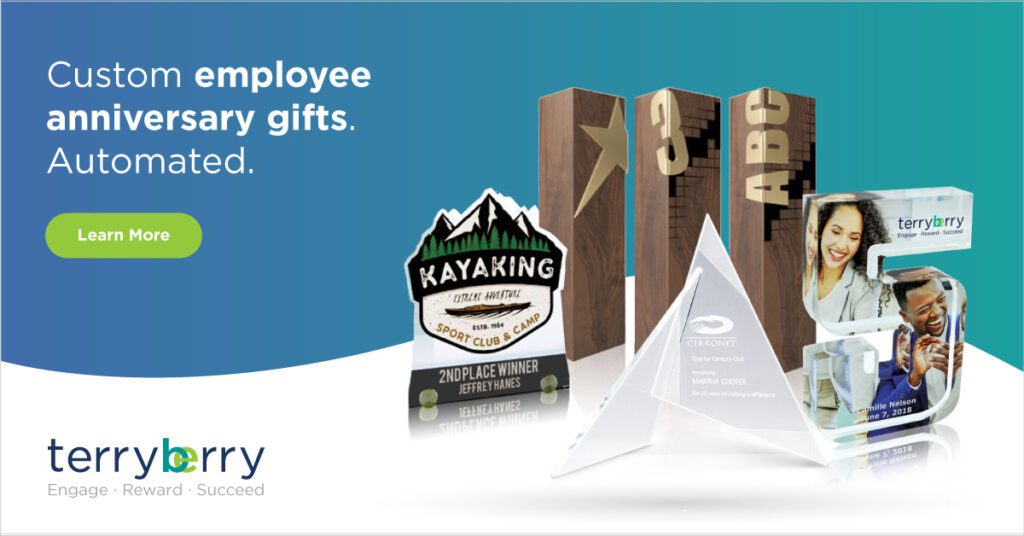April 17, 2025


Most businesses we speak to have certain ambitions in mind for their employee engagement program. They might want to reinforce company values, automate employee recognition, incentivize performance, improve employee wellbeing, or achieve more niche objectives like encouraging safety protocols.
But despite having their broad goals worked out, these organizations often still need to figure out:
- How to build always-on programs with goals tied to your core values or strategic business objectives.
- How to build a business case for your program(s). Your program might have a positive impact, but without the right data and analytics, you’ll struggle to show more than basic participation metrics or correlations.
- How to choose the right technology to design, launch, and scale your program(s).
In this guide, we answer these questions in detail, showing you how to create and scale your employee engagement program, measure its impact and ROI, and choose the right technology.
We also cover different ways to budget for your program, and how to choose the right one in case you don’t know which program(s) to implement after evaluating your team’s needs.
Quick links:
- Choosing the right engagement program for your needs
- Setting up your always-on recognition program
- Measuring performance and ROI
- Budgeting for your program
Over 40,000 organizations use Terryberry’s centralized employee engagement platform to run employee recognition, wellness, and listening programs tailored to their core values and strategic goals.
How to Identify Which Employee Engagement Program(s) You Need
If you need help deciding which type of employee engagement program to run, the starting point is to identify symptoms in your organization that signal employee disengagement and zero in on their causes.
Maybe retention is lower than you’d like it to be, or most people can’t recall your company values. Or managers are saying their top performers are burned out. Some signs of disengaged employees can be less obvious, too. Maybe one reason your sales team is struggling to meet its targets is disengagement — they don’t feel supported by leadership, connected to their peers, or recognized for their efforts.
For example, Amteck, a family-owned construction company with a reputation for incredible employee retention rates, approached us when the business faced challenges maintaining its culture and communicating core values as it scaled.
The signs of decreasing employee engagement included:
1. People were losing connection with core values.
Leadership knew these values well, but people on the ground were struggling to recall them. Matt Noble, Marketing and Communications Manager at Amteck, explained how they identified this problem:
"When we asked people about Amteck's core values, only 1 in 10 employees could articulate them correctly. This was a wake-up call, highlighting the need to show appreciation in ways that resonated and aligned with our core values."
2. The company wasn’t consistent with employee engagement and recognition.
"Our workforce doesn’t have that traditional 'watercooler' experience," Matt explains. "Some team members never meet their colleagues at other job sites or offices. We needed consistent ways to bring people together emotionally, even if they’re physically apart."
3. Their previous milestone program fell flat.
These challenges became apparent to Amteck after doing something simple like asking employees to recall the company’s core values. Failing to get a satisfactory answer, Amteck realized they needed to invest in engagement strategies that reinforced these values and celebrated people’s accomplishments.
If you don’t know the causes for disengagement in your company, the good news is you can methodologically uncover them using pulse surveys by collecting employee feedback from different sources (such as managers) and by talking to employees 1:1.
The goal isn’t to arrive at “Hey, we need to have an annual pizza party because people aren’t feeling the love” but to pinpoint specific gaps in employee engagement that can be solved with a tailored program.
So, you might instead arrive at conclusions like, “We need an employee wellbeing program that encourages our top performers to use their PTO and limit overtime,” or “We need to build a culture strongly rooted in our company’s core values. Let’s design a recognition program that encourages peers to nominate each other when they see fellow employees demonstrating these core values in their day-to-day.”
To help you pinpoint gaps in your employee engagement, we’ve developed a science-backed culture model to uncover specific insights and tailor your engagement program accordingly. Our culture model includes six engagement indicators: belonging, leadership, equity, purpose, empowerment, and wellbeing.
These indicators predict employee engagement.
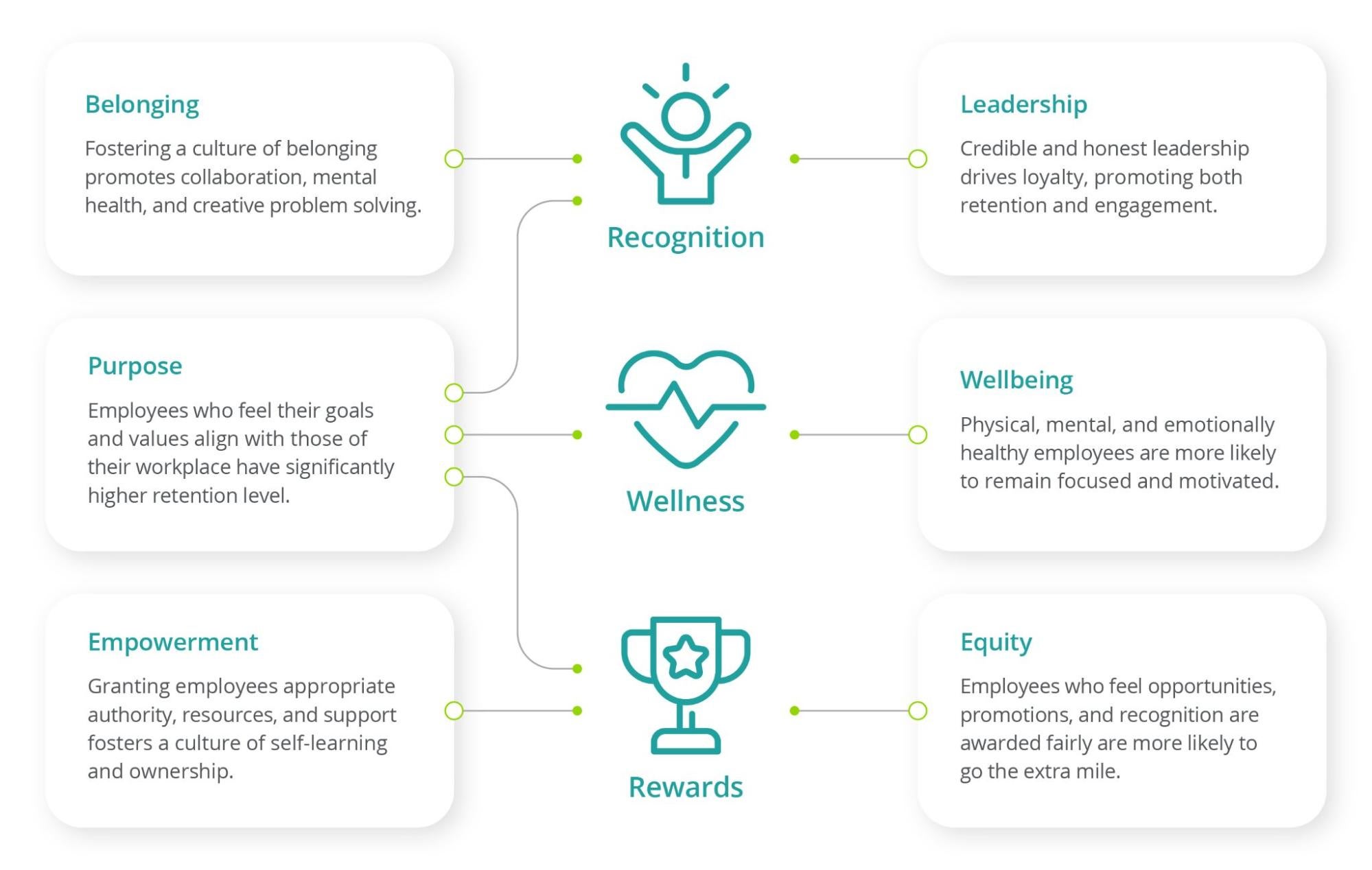

Terryberry’s employee listening tool includes ready-made surveys designed by PhD researchers and backed by I/O psychologists. It’s made to assess your team across six key engagement indicators, with each one tied to specific employee engagement outcomes. For example, employees who rate their leaders as effective and empowering are 4 times more likely to be engaged at work, demonstrating how “leadership” as an indicator predicts engagement.
You’ll find that different research bodies have their own approach to employee engagement indicators; the six we mentioned are used by thousands of our customers to develop successful employee engagement programs. When you combine this survey data with direct feedback, you’ll get a clearer picture of areas where employee engagement can be improved.
So, let’s say you learn from collecting feedback that a specific team isn’t very motivated, and then surveying that team reveals they score low in the “equity” category. This could signal that the particular team doesn’t feel recognized for their contributions and doesn’t believe they have opportunities to grow.
Importantly, when you’re collecting insights from surveys and directly, you might not always be looking for glaring issues. You’ll either walk away knowing exactly what gaps exist and need to be filled, or at least get a sense of where and how engagement needs to be improved.
Launching and Growing Successful, Performance-Driven Employee Engagement Programs: 6 Key Considerations
1. Aligning Your Program with Company Values & Goals
Designing your employee engagement program around core values or specific objectives gives you a strong foundation to show how it's driving strategic business goals. Otherwise, if your recognition program is seen as a tool for micro-bonuses and your wellness program is perceived as an alternative to a gym membership, leadership may see these programs as replaceable nice-to-haves, or even as cost centers.
But let’s say you build programs around clear objectives instead — like an incentives program to increase sales performance — and you’ve got the means to track the impact. Consequently, you can secure your seat at the table, showing leadership how your program is impacting wider business goals.
To build programs of this kind, you’ll need the right systems in place (facilitated by the right tech) that cultivate regular engagement and incentivize outcomes relevant to your goals.
Here’s more on how real-world companies achieve this:
How Chelsea Groton Bank Promotes Its Core Values with the Acorn Rewards Program
Chelsea Groton Bank, the largest mutual bank in Eastern Connecticut, approached Terryberry about developing a program to reinforce the company’s core values. For a company with more than 15 different branches, this meant building an always-on program connecting people across locations.
When the bank approached us, they already had a milestone awards program. For their custom recognition program, they wanted to create a gamified experience that encourages peers to celebrate each other’s day-to-day contributions around the company’s seven core values: being innovative, collaborative, trustworthy, professional, knowledgeable, versatile, and positive.
The “Acorn Rewards” program was born, which lets employees recognize each other with a “Purple Acorn” award when they see a peer demonstrating one of Chelsea Groton Bank’s seven core values.
For this purpose, we configured Terryberry’s “Give a WOW” feature to these nomination categories:
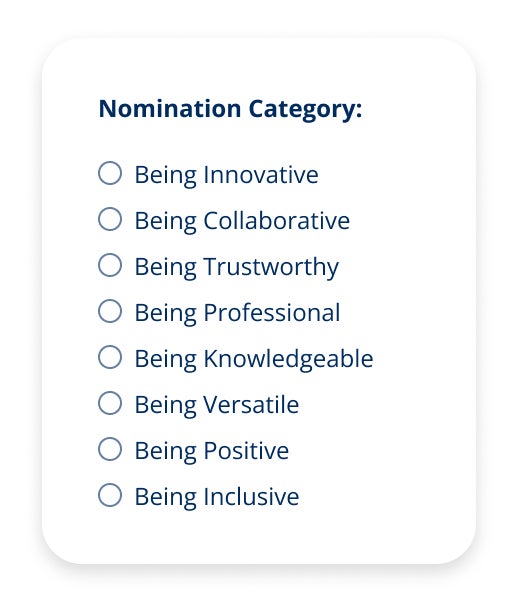

So when someone chooses to give a Purple Acorn award, they can select the appropriate core value. The redemption experience evolves as an employee collects more Purple Acorns; after the first ten, they’ll get a custom plush toy — the “Happy Squirrel” — which they can proudly display and even dress up for the holidays.
Then, for every additional 10 Purple Acorns they collect, they get reward points that they can redeem for luxury and lifestyle rewards.
Programs like Acorn Rewards, which tie core values to everyday recognition, are always reinforcing core values and motivating people to own them.
2. Getting Leadership Involved
Leaders and managers play a vital role in ensuring the employee engagement program is successful, far beyond signing off on budgets and managing approvals. Their participation signals the importance of these programs to their teams.
Beyond setting an example, managers and other organizational leaders may also have direct responsibilities that impact an engagement program’s success. For example, if you’re:
- Launching a wellness program to improve employee wellbeing and reduce burnout, each individual’s manager may directly impact these factors. Managers are either responsible for or influence their team’s work-life balance, the implementation of PTO policies, overtime, and stress.
- Creating a recognition program to celebrate people and increase their sense of belonging, then managers play a key role in recognizing their team’s achievements and special moments.
- Implementing an upskilling and career development program, you’ll need managers to weigh in on skills gaps in their team and offer suggestions for which type of training to prioritize. They can also identify which employees are most interested in upskilling themselves.
Once your program is up and running, it’s important to track manager participation, including how they’re engaging with the program.
If you’re using an employee engagement platform to manage your program, you can track program-specific insights like which managers are recognizing employees the most and least, or the impact on teams whose managers actively participate more in your program compared to those who don’t.
[Source: Insert image here]
Your program can also benefit from the feedback leaders collect directly from their team and their own observations. For example, here’s a big change Amteck discovered after implementing an awards and recognition program:
“Even the most reserved employees stood up proudly to receive their awards. The reactions were incredible. People stood straighter, smiled wider, and often became emotional. It surprised me just how much of an impact it had,” said Matt Noble, Marketing and Communications Manager at Amteck.
3. Facilitating and Encouraging Participation
You’ve planned out how to tie your engagement program to strategic goals and core values, and you’ve secured leadership buy-in. Your managers are genuinely interested in driving your program forward.
That means your program is guaranteed to succeed, right?
Not quite. There’s another major consideration: how do you motivate people to participate?
In our experience of working with more than 40,000 companies, programs that succeed the first time around are designed with a deep understanding of employees' needs, and they prioritize delivering fair, equitable experiences.
One of the most important considerations for encouraging participation is the incentives you choose for the program. The Happy Squirrel award in Chelsea Groton Bank’s program resonates well with their workforce, but it might not mean much to yours. The best incentive also varies depending on the program.
For example, the points system works well for always-on programs, like social recognition, because you can create a rewards catalog with different categories — like merch, swag, lifestyle, and travel rewards — allowing people to choose for themselves. But for an employee of the year program, maybe you’d want to develop a custom award to make it more personal. For an upskilling and development program, maybe you’d incentivize people by offering to cover tuition fees for certifications they’d like to pursue.
Beyond incentives, it’s also important to consider how to make your program personal, equitable, and easily accessible to your workforce. This means making it easy for people to participate, communicate with each other, and redeem their rewards.
For a social recognition program, this means bringing everyone together in one place:
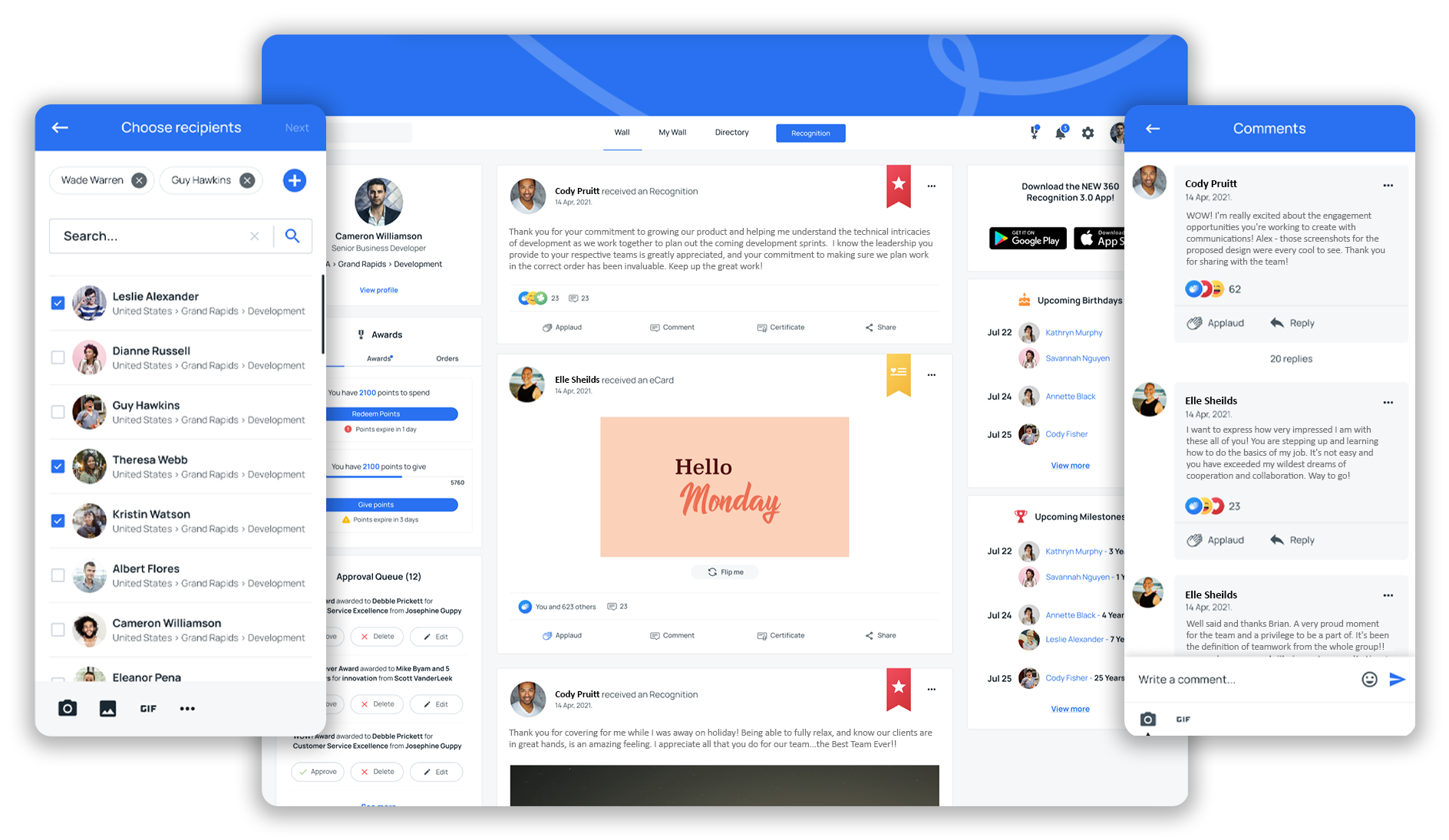

They can nominate each other, celebrate small and big moments, and engage with other people’s achievements.
You might also consider the following when designing your engagement initiatives:
1. Distributed teams
Having a team distributed across different national branches or countries adds another layer of considerations to your engagement programs. For example, let’s say a company with an internationally distributed team wants to launch an awards and recognition program.
Here, providing an equitable employee experience entails factoring in team members' purchasing power and pay structure in different countries. You’d also want to account for international fulfillment to avoid situations where shipping fees eat into the rewards budget.
2. Companies with both desk and non-desk workers
Do you launch separate employee engagement initiatives for these two segments? Or do you look to design a single program — like for recognition — that caters to both segments?
The decisions you take to make your program more inclusive can also impact how people participate in it.
For example, at Terryberry, we support employee recognition for non-desk workers by incorporating offline presentation items, offering redemption links for rewards, and supporting password-less logins. Password-less login options mean you can still engage employees without corporate emails in programs such as peer recognition.
But if you choose to use offline presentation offers and direct redemption links only, your program for non-desk workers becomes limited to on-the-spot recognition instead of being always-on and tied to cultivating your workplace culture.
There are actually two parts to answering the question, “How do we facilitate and encourage participation?” Answering the first part includes the considerations we’ve discussed above regarding incentives and experience.
The second part concerns how you achieve this practically at the operational level. That’s where choosing the right technology comes in. As we covered above, the platform you choose can make the difference between having non-desk workers actively participate in your recognition program or limiting them to redeeming awards only.
4. Measuring Your Program’s Performance & Impact
We’ve mentioned some metrics that can help you gauge employee engagement, like manager and employee participation metrics. But your program’s performance and impact really become clear when you combine three types of data:
- Participation metrics, including manager and employee participation, the number of program participants, and program-specific data (e.g., for a recognition program, what are the most common types of nominations?)
- Employee listening data, including eNPS, employee satisfaction, and engagement indicators. Our culture model’s six engagement indicators — belonging, leadership, equity, purpose, empowerment, and wellbeing — can help you predict employee engagement.
- Broader HR metrics, including absenteeism, voluntary turnover, and your retention rate. Highly engaged employees are less likely to quit, so turnover and retention metrics can speak to your company's culture and success or challenges in engaging its workforce.
Terryberry’s employee engagement platform helps you collect these insights in a single place, so you can build a business case for your program by proving its impact. For example, you could measure and show:
- How your recognition program impacts eNPS
- The impact of your wellness program on employee engagement and retention
- The impact of manager recognition on team performance
If you configure Terryberry’s employee engagement platform for your program, you can use its analytics to measure all this and see how your programs impact factors like leadership acceptance, retention risk, and employee wellbeing.
Terryberry’s analytics include both data relevant to your program and insights that you collect via surveys (employee listening). Here’s an example of what your recognition program’s analytics might look like:
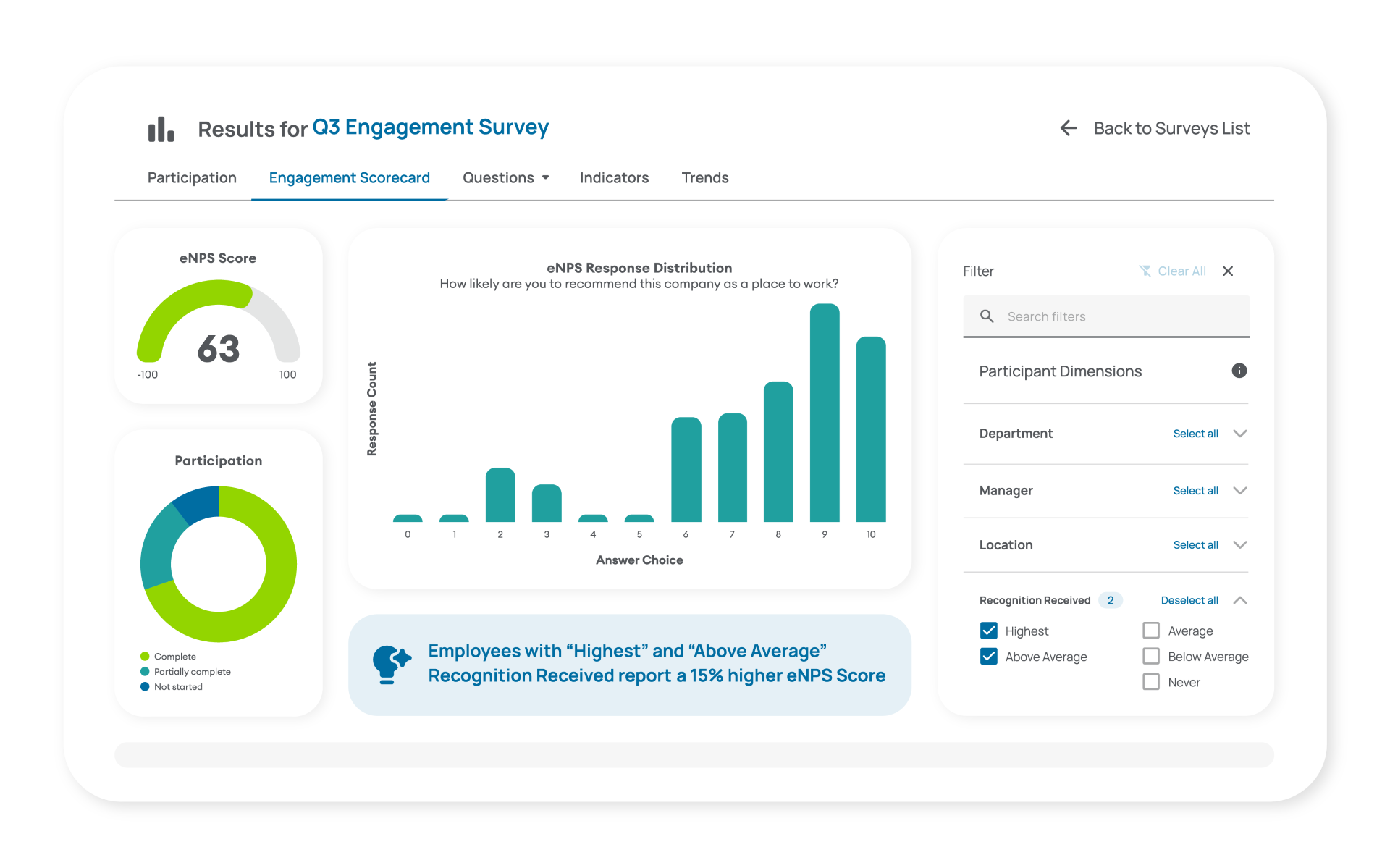

Here, you can select specific filters to uncover trends. For instance, not only can you filter for “highest” and “above average” recognition received, but you can also add department-specific filters to discover eNPS trends unique to different teams.
The employee listening insights you collect using Terryberry’s ready-made employee engagement surveys measure the six engagement indicators in our culture model. So your results might look like this:
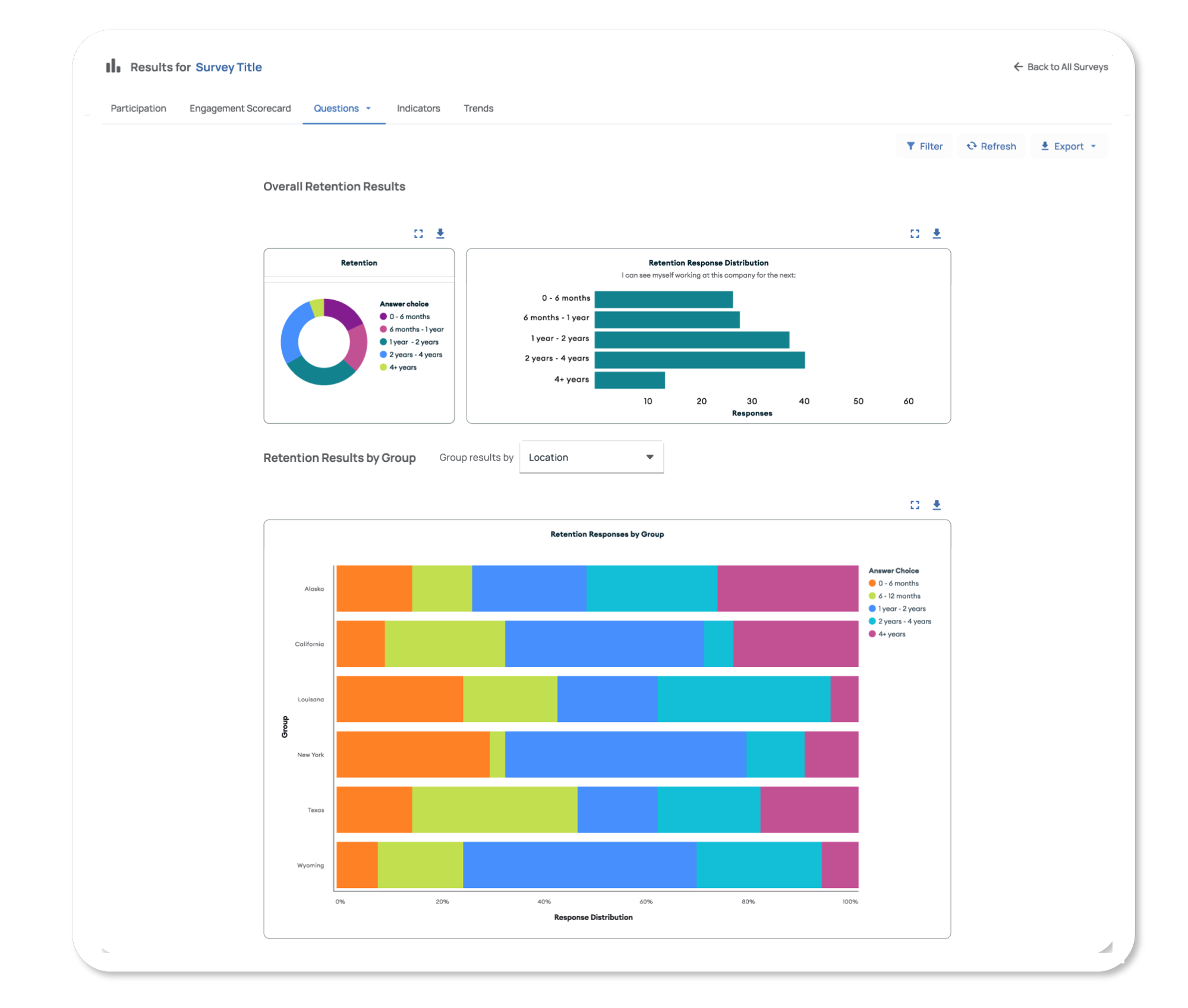

You can combine this data with analytics from your program to uncover actionable insights relevant to specific cohorts. For example, you could check which engagement indicators your most and least recognized employees score the highest and lowest in.
Let’s say you discover that your most recognized employees don’t score well in “equity” — this could signal an underlying problem with career development opportunities. Maybe your top performers don’t believe they have sufficient promotion opportunities. You can take this data to leadership with a proposed action plan and launch engagement initiatives to address the gap.
Unlike many other employee engagement platforms, Terryberry offers recognition, wellness, and listening capabilities in a single, integrated platform. Platforms that take a modular approach (e.g., separately offering listening and recognition) keep the data from your different programs separate, preventing you from uncovering broader trends and patterns.
Terryberry is the only employee engagement platform that lets you measure how employee wellness, recognition, and listening impact each other.
5. Choosing the Right Technology
Many companies that approach us about launching employee engagement programs previously ran basic initiatives, like milestone awards using a low-tech approach (e.g., managing nominations and approvals via a spreadsheet). But when they move towards mature, always-on engagement programs tied to performance and ROI, they know it’s time to invest in an employee engagement platform.
The category for employee engagement platforms is quite broad; even sub-categories, like employee recognition software, include dozens of software vendors. You’ll find tools that are more niche, like ones that let you automate gifting or run simple wellness programs to encourage personal fitness. But with Terryberry, our employee engagement platform is ideologically different from tools that emphasize off-the-shelf engagement.
Most platforms only address the operational and administrative side of employee engagement. Recognition tools offer extensive rewards catalogues and let you automate nominations and approvals, while wellness apps deliver personal wellness content to each employee’s inbox.
These capabilities are crucial for helping you run and scale your programs on autopilot, which is why Terryberry automates these administrative and operational fundamentals too. But our platform is tied to our deeper philosophy of building performance-first programs that have a real, measurable impact.
That’s why Terryberry is designed to help you build highly personalized engagement programs that move the needle, rooted in your core values or strategic goals. This means we configure:
- How employees engage with the platform, such as your nomination workflows, how people celebrate each other, login types (e.g., password-less for non-desk workers), and redemption experiences (e.g., location-based for distributed companies).
- The experiences for leadership, including approval workflows, and how and when they give out awards.
- The incentives themselves, beyond tying them to specific values or outcomes. We can also customize the awards themselves, making us one of the only two employee engagement platforms that manufacture awards ourselves.
After your tailored program is up and running, we work with you to measure performance and build your business case. Improving employee engagement isn’t a “set and forget” process; it’s continuous.
You might launch a program to achieve specific initial goals, like improving retention, and as the data comes in, you’ll identify more opportunities to have an impact with different engagement strategies. For example, most companies we work with start off with employee recognition and listening, but they might add a wellness program after a year or two.
When you’re analyzing data from your first program, maybe you’ll uncover that specific departments need to develop leadership teams more. Or maybe, since leadership’s now convinced of your program’s impact, they approach you about developing an incentives program to boost sales performance specifically. If you’re managing employee engagement from Terryberry’s centralized platform, it’s easy to monitor performance consistently and launch new, tailored programs quickly.
6. Budgeting According to Your Needs
Just like the programs themselves, there’s no one-size-fits-all approach to budgeting for your employee engagement program. Your goals, organizational structure, existing performance (retention, productivity), and the type of program you choose are the main factors that can influence your budget.
Having said that, there are three main budget structures that organizations usually adapt and tailor to their program. These are:
- Percent of payroll: This usually involves allocating 1–2% of payroll expenses towards your employee engagement program, although some companies do allocate a lower percentage. For example, if you allocate $50 million annually for payroll, you might aim to set aside at least $500k annually for your employee engagement program.
- Per employee: Some organizations budget for their program based on headcount. In this method, you’d need to decide how much you plan to spend on each employee per year. For reference, the average budget for a recognition program is $30-50 per employee, according to Recognition Professionals International. High-performing companies allocate up to $150 per employee on average (excluding service awards). If your team is distributed across countries with different purchasing powers, you might want to segment your per-employee spending accordingly.
- Per years of service: For this budgeting structure, you’d allocate a dollar amount for each year an employee is with your company. This structure can work best for years-of-service or milestone recognition programs. We recommend budgeting around $35 per year of service, per employee. So if someone’s just completed 5 years of service, they’d be awarded a gift or custom award valued at $175.
Keep in mind that if you plan to run the program using an employee engagement platform, you’ll need to budget for that separately. If you’re looking for more detailed guidance on how to budget for employee engagement, check out our guide.
Launch & Scale Tailored Employee Engagement Programs and Measure ROI with a Single, Centralized Platform
Terryberry’s highly configurable employee engagement platform lets you launch and scale custom employee recognition, wellness, and listening programs in a single place. We’ll personalize the Terryberry platform to your unique needs and strategic goals, and work with you to measure your program’s performance and build a business case.
Leverage Terryberry’s deep analytics to analyze how engagement evolves with data visualization of trends, heatmaps, and people data filters. Use the data you uncover to launch tailored micro-programs that address the needs of specific cohorts, like programs that help top performers avoid burnout or make minority employees more included and connected to your company culture.
Schedule a demo with our team to grow your performance-driven employee engagement programs.

